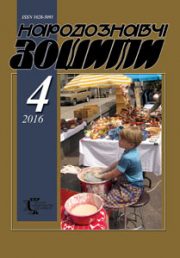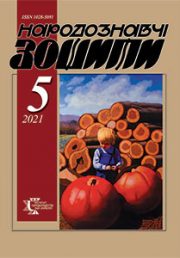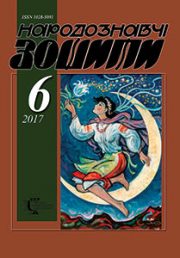Publications
Publications in foreign languages
Art at the Service of Charity
Maryana Levytska
Art at the Service of Charity. Appearance of a new Social Practices. (Art Exhibition of the 1847th in Lviv to Benefit the Poor)
The awareness of keen social responsibility for the fate of the poor, the orphans and the handicapped became an important achievement of the Enlightenment. The authority of the church in the matters of charity remained strong enough during the 19th century. At the same time there appeared new secularized charity practices . Spreading of charitable activities in the 19th century took place mainly in the cities. The goal of Charity societies was the liquidation or limitation of the most awful examples of misery and the begging practices. Great European cities in the 19-th century had different institutions for the blind, the deaf and the dumb, boarding schools for the orphans, schools for poor children. Part of the funds for these needs was given from the city budget, part of these funds was raised by private foundations. For example, the 19th century Krakow was the city in the Central Europe that had a lot of charity foundations. On the whole, this “Fashion for charity” was wide spread in the middle of the 19th century. It was the responsibility of women from rich aristocratic or burgher families. They organized different gala balls, celebrations and lotteries which were meant for the needy.
Genre Characteristics of Kolomyikas
Оlha Кovalchuk
Genre Characteristics of Kolomyikas and their Functional Nature
The subject of our article became genre nature of kolomiykas in comparative context with Slavic small song genres. Textual approach and criteria for defining kolomiykas are not sufficial when dealing with syncretic masterpieces: there is not enough focus put on the scope and content, as it did V. Hnatiuk [14, p. XIII], size, rhythm and frequent connection with dance — A. Zachynyayev [9, p. 317] or rytm and melody — V. Goshovsky [8, p. 146—210]. As the key differentiators here should serve multiple factors that can not be avoided in determining genre affiliation of songs. These are: a) the form, composition, means of artistic language; b) the content; c) rhythm, melody; d) the presence or absence of dance accompaniment, manner of its presentation, facial expressions and gestures; e) restriction to certain situations (picking up berries, mushrooms, housekeeping, grazing, fun) or absence of such «dedication». So, when fixing folklore material, we tried to avoid subjectivity, using video recording technique, which enabled analyze texts, melodies, dance moves, facial expressions, gestures, emotional state soloists, environment and runtime, music and reception. Thus, penetrating into the essence of the phenomenon, we have come to their own definition of the term «kolomyiky» — as a short two-tree lined of various themes songs to dance or for singing with typically 14 syllabled verse, rhythm (4+4+6) with caesura in the middle, chromatic melody in a small vocal range, final, sometimes the inner feminine rhyme that are prevalently sung in the western regions of Ukraine…
The radical FEMEN
Mariya Majerchyk, Olha Plakhotnik
The Radical FEMEN and The New Women’s Activism
FEMEN is a radical women’s movement that originated in Kyiv about two years ago. National newspapers, magazines, television, and internet sites all beam with childlike exaltation savoring the appealing defiance of FEMEN’s street actions: activists protesting topless.
When in the space of two years FEMEN’s protests did not stop – in fact, they became more frequent and more daring – when the movement did not join a political party, did not become a mouthpiece for a candidate at the next elections, and did not turn into a business project, then the claims that FEMEN was just a puppet organization somewhat dwindled.
Beauty will save the world
Oksana Kis’
“Beauty Will Save The World!”: Feminine Strategies in Ukrainian Politics and the Case of Yulia Tymoshenko
September 1, 2005. The traditional annual celebration of the “first bell” takes place at the primary school of Sosnivka, a small coalE mining town in Western Ukraine.[1] The firstEgrade
students are presenting a short performance. A tiny girl, Darynka, dressed in a lacy skirt, a red jacket with a downy collar and a wrapEaround braid borrowed by her grandmother
from a beauty salon especially for the occasion) comes to the front. She recites with special expression a poem written by her female teacher.
Displaced Memories of a Displaced People
Oksana Kis
Displaced Memories of a Displaced People: Towards the Problem of Missing Polish Narratives in Lviv
Every time when it comes to discussion on historical memory, I recall one story told by an elderly woman long ago. It was in mid 1980s, I was a teenager then and she was probably in her sixties. We were stuck together in a hospital room for about one week. The old lady was quite talkative so I had a chance to hear a lot about her life. With time most of that has been forgotten, but one story gives me no rest even today.
Biography as Political Geography
Oksana Kis’
Biography as Political Geography
Patriotism in Ukrainian Women’s Life Stories
The history of Ukraine in the twentieth century abounds in events that have altered the country’s political, social, and economic landscapes, yet the part that Ukrainian women played in that history during the past hundred years is only marginally visible. The gender dimension of that entire epoch is especially important; it represents an era when Ukrainian women obtained broad rights and opportunities for self-realization in their public lives, a trans- formation that changed both the women and the public space. For all that, women’s lives remained virtually unseen in the
historical records.1 This is a serious lapse in our study of Ukrainian history, especially in light of the fact that women are the key agents of socialization.
The identity of the Polish-Ukrainian borderland
Roman Chmelyk, Lech Mróz
The identity of the Polish-Ukrainian borderland in the context of the European aspirations
The outcome of the negotiations between the Ukrainian authorities and the European Union, meanders of President Janukovych’s policies and actions, the Ukrainian society torn apart between its European and proRussian aspirations are another good illustration of the situation well familiar not only to close observers of political processes in this part of Europe. Already the Orange revolution, as a result of which Viktor Yushchenko came to power in 2005, demonstrated the lack of social and national unity in Ukraine. This lack of unity is much deeper than in any other state in this part of Europe. As we know, Viktor Yanukovych’s attempt to come to power was accompanied not only by electoral fraud, but also by an attempt to poison Viktor Yushchenko in order to eliminate him – not just in the political sense – from the presidential race.






